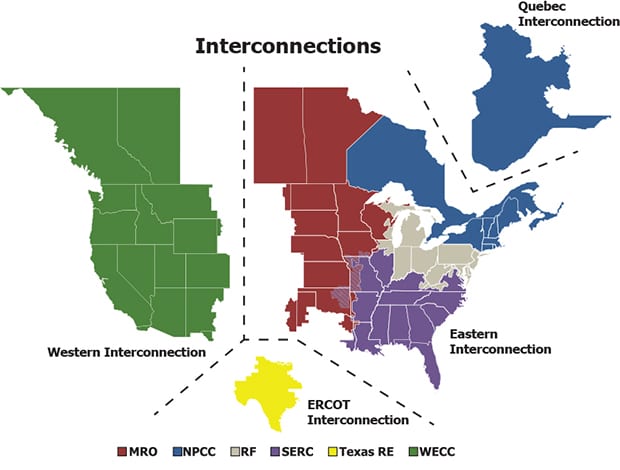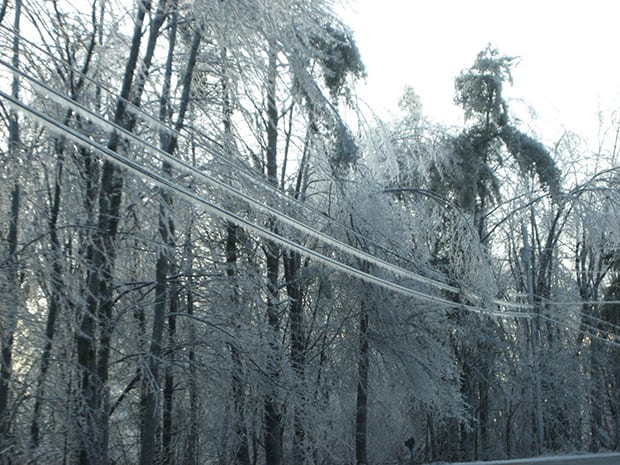NYC Blackout Highlights Importance of NERC’s New Regulation
The North American Electric Reliability Corp. (NERC) recently issued a regulation for all power producers to test their electrical systems for proper coordination between protective relays. This protective-relay coordination standard number 27 (PRC-27) presents a big challenge for all power plants, but particularly for combined cycle/cogeneration plants, whose lean staffs lack the electrical engineering personnel needed to comply with it.
This regulation didn’t come about just because of some theoretical hypothesis. It was a much-needed response to the real-life Northeast blackout of 2003. As you might recall, that was an extended and widespread power outage affecting millions of customers in the U.S. Northeast, Midwest, and in the Canadian province of Ontario. This outage exposed the North American Eastern Interconnect’s (Figure 1) vulnerability to voltage fluctuations caused by ground faults—such as high-voltage lines sagging into trees due to the heat of summer or due to ice buildup in winter (Figure 2).
 |
| 1. The North American grid comprises four distinct interconnects. Note that Quebec and Texas proudly stand alone. Source: NERC |
 |
| 2. Protective relays must be able to sense and respond to ground faults caused by ice buildup on transmission lines. Courtesy: Kevin Micalizzi/Flickr |
Eight years after the great Northeast Blackout of 2003 came the great Southwest Blackout of 2011, affecting millions of other customers in Arizona, southern California, and Baja California, Mexico. Both blackouts forced schools and businesses to close, and airlines to cancel flights. Even beaches were forced to close, because sewage-pumping stations lost power and spilled raw sewage onto the shoreline.
This week, New York City (NYC) was again affected by a widespread blackout. Con Edison’s preliminary review of system data found “that the relay protection system at [its] West 65th Street substation did not operate as designed,” the company said in a press release. It was clearly a case of one electrical disturbance not being properly isolated—as it should have been by protective relays—then spreading throughout the grid until the entire city went dark.
When the grid goes down, our entire country grinds to a halt. To prevent these widespread outages, we must have strong interconnects between our generation, transmission, and distribution systems, which is the purpose of PRC-27. Strengthening our interconnects also will help ease cybersecurity, anti-terrorism, and grid modernization concerns—the smart-grid efforts that you hear about.
There are three requirements of PRC-27, which together make it clear that the old “set it and forget it” mentality regarding protective relays is no longer acceptable. In the past, a power plant’s protective–relay settings were calculated during the design phase, set and tested during the commissioning phase, and then pretty much left alone during commercial operation. But now, PRC-27 requires every plant to re-calculate and update its protective-relay settings. That’s the first requirement of PRC-27. In other words, NERC wants you to review and update your settings, because things like plant upgrades can change what your settings should be.
For example, one HRSG user from a cogen facility in Wisconsin told us that he added capacity some years ago—installed some more gas turbines—and his subsequent PRC-27 study showed that he needed to change his relay settings. This tells us that PRC-27 is already having a positive impact, that it’s already strengthening the grid. After the HRSG user changed his settings, he reported his new numbers to the owners of his transmission lines (as PRC-27 requires) because his changes affected the relay settings on their lines. The opposite is true too. When the line owners conduct their PRC-27 studies, their changes will affect the settings in each power plant. At the risk of sounding redundant, we might say that “your coordination study must be coordinated with their coordination study.”
The second requirement of PRC-27 is to do your review and update periodically, per a schedule based on the voltage of your equipment. For most HRSG users, the periodicity is every six years. The third requirement of PRC-27 is to conduct practical tests proving that the protective relays actually do what they’re designed to do—sense a fault and actually trip the circuit breaker. To complete these practical tests, your electrical tester must simulate a fault on the secondary side of the current transducers.
One HRSG user at a small cogen plant told us his staff doesn’t include compliance specialists like the manager of a large utility plant can afford to have. He said that he tries to keep abreast of all the regulatory changes, but for one guy, by himself, it’s pretty overwhelming. “And it’s not just all these Federal regs like PRC-27,” the plant manager said. “My plant’s in California, so I also gotta comply with a shipload of California state regs, and local ordinances on everything from the water usage of our lawn sprinklers to the stormwater runoff from our plant. Oh, and anytime a state reg conflicts with a Federal reg—which happens a lot—then I gotta comply with the stricter of the two!”
Full compliance with PRC-27 won’t stop all blackouts, but it will keep them isolated near the ground fault, instead of spreading until they affect millions of customers.
—Scott Dude is president of Dude Electrical Testing and Rob Swanekamp, PE is executive director of HRSG User’s Group Inc. This article is based on a presentation given at the HRSG User’s Group Conference, April 26, 2019.